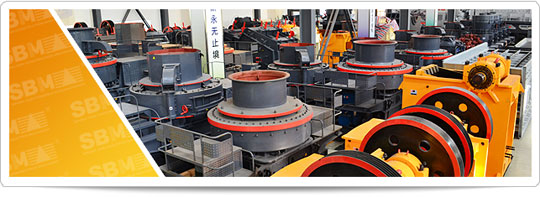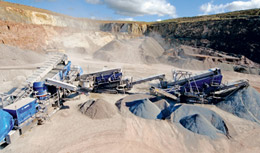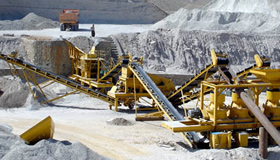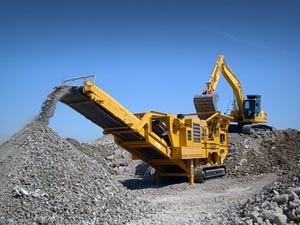-
Sand Making Crusher
- PCL-Vertical Shaft Impact Crusher
- SBM Hydraulic VSI Crusher
- VSI5X Series Impact Crusher

Track ballast process flow

Raw materials are transferred to jaw crusher via vibrating feeder from hopper for primary crushing, then primary crushing products are transferred to impact crusher through belt conveyor for secondary crushing. The secondary crushing products will be transferred to the vsi stone crusher for shaping after which the finished ballast is mainly cubic, and separated to different sizes. The aggregate of suitable size will be transferred to the final product pile, while aggregate of unsuitable size to the crushing machine for re-crushing.
Advantages of SBM track ballast production line

1. Product with needle plate type is no more than 5%. If crushed by Jaw Crusher and Impact Crusher, content of needle plate type is more than 10%, but with VSI Series Vertical Shaft Impact Crushers, it will be reduced to 4.7%.
2. The crushing and screening capability can be from 50 tons per hour to 600 tons per hour. The production improves 50% compared with using Impact Crusher as the final crushing processing.
3. With Impact Crusher and Vertical Shaft Impact Crusher, the consumption of wear-parts is reduced greatly in the whole process.
4. The final products are graded and separated according to customers' requirements and the size can be from 0 to 50 mm.
5. The advanced electric control panel can assure the whole process discharge smoothly, running reliable, operation easily and high efficiency in power consumption.
6. The duster is attached for the environment protection.
Main equipments of track ballast production line
Track ballast crushing and screening plant consists of the following equipments:
Vibrating feeder, Primary-crushing machine: Jaw crusher, Secondary-crushing (fine crushing) machines: Impact crusher, cone crusher, Shaping machine: VSI stone crusher , Vibrating screen, Belt conveyor
Application of track ballast

Track ballast forms the trackbed for railway sleepers or railroad ties or the supporting bed for road. It should be strong, hard-wearing, stable, drainable, easy to clean, workable, resistant to deformation, easily available, and reasonably cheap to purchase. Good quality track ballast is made of crushed natural rock with particles between 28mm and 50mm in diameter. Angular stones are preferable to naturally rounded ones. Soft materials such as limestone are not particularly suitable; granite is one of the best raw materials of track ballast.

- Capacity 40-60 TPH
- Capacity 100-120 TPH
- Capacity 150-180 TPH
- Capacity 200-250 TPH
- Capacity 300-350 TPH
- Capacity 350-400 TPH
- Capacity 500-600 TPH
- Capacity 600-800 TPH
- Capacity 800-1000 TPH
- Magnetite ore screening plant
- Coal Preparation Plant
- Sand Making Production Line
- Concrete Crushing Equipment
- Iron Ore Crushing Plant
- Coal Crushing Plant
- Aluminum Ore Crushing Line
- Cement Grinding Plant
- Construction Aggregate plant
- Antimony Ore Crusher Plant
- Gold Ore Crushing plant
- Nickel Crush Grinding Plant
- Aggregate Crushing Plant
- Track Ballast Production
- Gypsum Powder Line
- Australia Crushing Line
- Project from Hyman
- Project from Grover
- Project from Abbott
- Grinding line for USA
- Romania Crushing Line
- Russia Grinding Line
- Project from Joshua
- Ethiopian Potash Project
- Amessmessa Gold Project
- Gold Project for Ghana
- Project for Nigeria
- Project From Faida
- Project from CGO
- Project from Lucky
- Industrial Supplies for India
- Panama portable crushing project
- About Us
- |
- Service
- |
- News & Events
- |
- Contact Us
- |
- Resources
- |
- Showroom
Aggregate Crusher
Artificial Sand Making
Ballast Crushing Machine
Basalt Stone Crusher
Barite Mine Process
Beneficiation Plant
Bentonite Crusher
Bentonite Milling
Calcium Carbonate Crusher
Calcium Carbonate Grinding
Cement Grinding
Concrete Crusher
Coal Crusher
Copper Crusher
Cement Mill
Chrome Mining Process
Copper ore Beneficiation
Coal Processing
Coal Pulvarizer
Feldspar Crushing
Feldspar Grinding
Flotation Machine
Gold Crusher
Gold Mine Equipment
Gold Processing Machinery
Granite Crusher
Granite Crushing Machine
Granite Quarry Equipment
Gypsum Crusher
Gypsum Mining
Gypsum Powder Production
Iron Ore Beneficiation
Iron Ore Crusher
Kaolin Processing Plant
Limestone Crusher
Silica Sand Crusher
Iron Ore Mining Equipment
Cement Production Line
Talc Production Line
Quartz Crushing Machine
Limestone Mining Process
Manganese Benificietion























